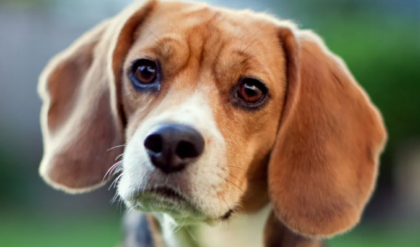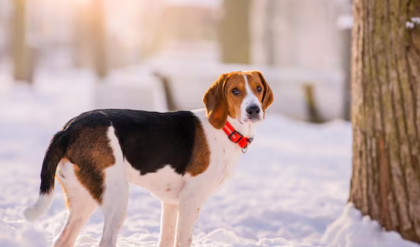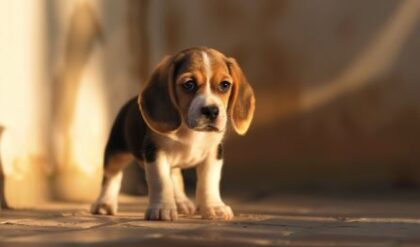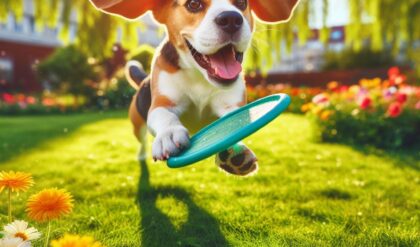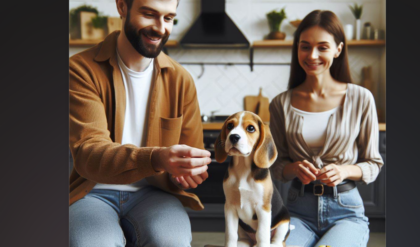Potty training a Beagle puppy can be a challenging task, but with patience, consistency, and the right approach, you can successfully potty train your furry friend in a relatively short period of time. Beagles are intelligent, energetic, and food-motivated dogs, which can work in your favor during the potty training process.

Understanding Your Beagle Puppy
Beagles are known for their strong sense of smell, which can make them easily distracted during potty training. Additionally, they can be stubborn and may require more patience and consistency than other breeds. It’s essential to understand your Beagle’s personality and behavior to tailor the potty training process to their needs.
Beagle Puppies and Their Potty Habits
- Puppies have small bladders and will need to go potty more frequently than adult dogs.
- Beagles are known for their love of food, which can be used as a positive reinforcement during potty training.
- They may be more prone to marking their territory indoors if not properly trained.
Establishing a Routine
- Set a consistent schedule for feeding, playtime, and potty breaks.
- Take your puppy out first thing in the morning, after meals, after playtime, and before bedtime.
- Choose a specific potty area and take your puppy there consistently.
Preparing the Potty Training Area
- Choose an easily accessible area for potty training, such as a fenced yard or a designated potty spot.
- Use a potty training pad or a litter box if you live in an apartment or have limited outdoor access.
- Make sure the potty area is clean and free from distractions.
Crate Training for Potty Training Success
Crate training is an effective tool for potty training Beagle puppies. It takes advantage of their natural instinct to avoid soiling their den area. However, it’s crucial to introduce the crate gradually and positively to prevent any negative associations.
Choosing the Right Crate
- Select a crate that is large enough for your puppy to stand, turn around, and lie down comfortably.
- Avoid using a crate that is too large, as it may encourage your puppy to potty in one corner.
Crate Training Techniques
- Introduce the crate gradually by placing treats and toys inside, and keep the door open initially.
- Feed your puppy meals in the crate to create a positive association.
- Never use the crate as punishment; it should be a safe and comfortable space.
Crate Training Schedule
- Puppies should not be left in the crate for extended periods, especially when they are very young.
- Gradually increase the time your puppy spends in the crate, starting with short intervals.
- Take your puppy out for potty breaks immediately after they wake up from a nap or after a period in the crate.
Positive Reinforcement and Potty Training
Positive reinforcement is a crucial component of successful potty training. By rewarding your Beagle puppy for desired behavior, you can reinforce good habits and make the process more enjoyable for both of you.
Using Treats and Praise
- Choose high-value treats that your puppy finds irresistible, such as small pieces of cooked chicken or low-calorie training treats.
- Praise your puppy enthusiastically and provide a treat immediately after they potty in the designated area.
Clicker Training
- Clicker training is an effective method for reinforcing desired behavior.
- When your puppy potties in the right spot, click the clicker and immediately provide a treat.
- Over time, your puppy will associate the click with the desired behavior and the treat.
Avoiding Punishment
- Never punish your puppy for accidents; this can create fear and make potty training more difficult.
- If you catch your puppy in the act of pottying indoors, interrupt them with a firm “no” and immediately take them outside to their potty area.
Dealing with Potty Training Setbacks
Potty training setbacks are common, especially with Beagle puppies. However, staying patient and consistent is key to overcoming these challenges.
Recognizing Potty Training Regression
- Potty training regression can occur due to changes in routine, stress, or health issues.
- Signs of regression include frequent accidents, marking behavior, and reluctance to potty in the designated area.
Addressing Potty Training Regression
- Go back to the basics and increase supervision and frequency of potty breaks.
- Consult with your veterinarian to rule out any underlying medical issues.
- Remain patient and consistent, and avoid punishing your puppy for accidents.
Preventing Future Setbacks
- Stick to a consistent routine and avoid major changes, if possible.
- Gradually introduce new environments or situations to minimize stress.
- Provide plenty of mental and physical stimulation to prevent boredom and destructive behavior.
Advanced Potty Training Techniques
As your Beagle puppy progresses in their potty training, you may want to consider some advanced techniques to reinforce good habits and facilitate the process.
Teaching Potty Commands
- Assign a specific command, such as “go potty,” and use it consistently when taking your puppy to their designated area.
- Reward your puppy with praise and treats when they obey the command.
Introducing Bell Training
- Hang a bell or a set of bells near the door leading to the potty area.
- Teach your puppy to ring the bell before going outside by ringing it yourself and then immediately taking them out.
- Over time, your puppy will learn to ring the bell to signal their need to go potty.
Transitioning to Outdoor Potty Training
- Gradually transition your puppy from indoor potty pads or litter boxes to an outdoor potty area.
- Start by taking your puppy out immediately after they potty indoors and rewarding them for going in the designated outdoor area.
- Increase the frequency of outdoor potty breaks and reduce the use of indoor potty areas.
Conclusion
Potty training a Beagle puppy requires patience, consistency, and a positive approach. By understanding your puppy’s needs, establishing a routine, and using positive reinforcement techniques, you can successfully potty train your furry friend in a relatively short period of time. Remember to celebrate each milestone and enjoy the process, as potty training is an essential part of responsible pet ownership.
Potty training a Beagle puppy can be a challenging but rewarding experience. By following the right techniques and being consistent, you can successfully teach your puppy where and when to potty. In this article, we have covered various aspects of potty training, from setting up the potty area to dealing with setbacks and advanced training techniques. Let’s recap some key points to help you on your potty training journey.
Establishing a Potty Training Routine
Establishing a consistent potty training routine is essential for success. Here are some tips to help you create an effective schedule for your Beagle puppy:
- Set a Schedule: Take your puppy out first thing in the morning, after meals, after playtime, and before bedtime. Consistency is key to reinforcing good potty habits.
- Designate a Potty Area: Choose a specific spot for your puppy to potty, whether it’s outdoors in a yard or indoors on a training pad. Consistency in location will help your puppy understand where they should go.
- Use Positive Reinforcement: Reward your puppy with treats and praise when they potty in the designated area. Positive reinforcement helps reinforce good behavior and makes the training process more enjoyable for your puppy.
- Monitor Behavior: Keep an eye on your puppy’s behavior and body language to anticipate when they need to go potty. Signs like circling, sniffing, or whining can indicate that it’s time for a bathroom break.
- Be Patient: Potty training takes time and patience. Remember that accidents will happen, and it’s essential to stay calm and consistent throughout the training process.
Preparing the Potty Training Area
Creating a suitable potty training area is crucial for successful training. Whether you’re using outdoor space or indoor pads, here are some considerations for setting up the perfect potty spot:
- Choose an Accessible Area: Select a potty area that is easily accessible for your puppy. If you live in an apartment, consider using a potty pad or litter box as an indoor solution.
- Keep It Clean: Ensure that the potty area is clean and free from distractions. Beagles are scent-driven dogs, so a clean area will help them focus on the task at hand.
- Use Training Aids: Consider using potty training pads or artificial grass to help guide your puppy to the correct potty spot. These aids can be especially useful for indoor training.
- Supervise Outdoor Time: When taking your puppy outside to potty, supervise them closely to prevent wandering off or getting distracted. This will help reinforce the idea that outdoor time is for pottying.
- Consistent Location: Whether indoors or outdoors, choose a consistent location for the potty area. This will help your puppy associate that spot with going potty and reduce confusion.
By preparing a dedicated potty training area and following a consistent routine, you can set your Beagle puppy up for success in their potty training journey.
Crate Training for Potty Training Success
Crate training can be a valuable tool in potty training your Beagle puppy. When done correctly, crate training utilizes your puppy’s natural instincts to create a safe and comfortable den environment. Here are some tips for successful crate training:
- Choose the Right Crate Size: Select a crate that allows your puppy to stand, turn around, and lie down comfortably. The crate should not be too large, as this may encourage pottying in one corner.
- Introduce the Crate Gradually: Make the crate a positive space by gradually introducing it to your puppy. Place treats and toys inside to create a positive association before closing the door.
- Feed Meals in the Crate: To further reinforce positive associations, feed your puppy their meals inside the crate. This will help them view the crate as a safe and enjoyable space.
- Avoid Prolonged Confinement: Puppies should not be left in the crate for extended periods, especially when they are young. Start with short intervals and gradually increase crate time as your puppy becomes more comfortable.
- Use the Crate Wisely: Never use the crate as a form of punishment. It should always be a positive and safe space for your puppy to retreat to.
By incorporating crate training into your potty training routine, you can provide your Beagle puppy with a secure and comfortable environment while encouraging good potty habits.
Positive Reinforcement and Potty Training
Positive reinforcement is a powerful tool in potty training your Beagle puppy. By rewarding desired behaviors and using praise effectively, you can motivate your puppy to continue exhibiting good potty habits. Here’s how you can incorporate positive reinforcement into your training:
- Reward with Treats: Choose high-value treats that your puppy finds irresistible, such as small pieces of cooked chicken or training treats. Immediately reward your puppy with a treat after they potty in the designated area.
- Praise Enthusiastically: In addition to treats, praise your puppy enthusiastically when they potty in the right spot. Use a happy tone of voice to show your approval.
- Clicker Training: Clicker training can be a useful method for reinforcing good potty behavior. Pair the click sound with a treat immediately after your puppy potties in the designated area.
- Avoid Punishment: Never punish your puppy for accidents or mistakes during potty training. Punishment can create fear and anxiety, making the training process more challenging.
- Consistency is Key: Be consistent in your use of rewards and praise. This will help your puppy understand which behaviors are desirable and increase the likelihood of them repeating those behaviors.
By utilizing positive reinforcement techniques, you can make potty training a positive and rewarding experience for both you and your Beagle puppy.
Dealing with Potty Training Setbacks
Potty training setbacks are common during the training process, but they can be managed with patience and consistency. Here are some strategies for addressing setbacks and regaining progress in your Beagle puppy’s potty training:
- Recognize Regression Signs: Be aware of signs of potty training regression, such as frequent accidents, marking behavior, or reluctance to potty in the designated area. Identifying these signs early can help you address the issue promptly.
- Revisit Basic Training: If your puppy experiences setbacks, go back to basics by increasing supervision and potty breaks. Re-establish a consistent routine to help your puppy get back on track.
- Consult with a Veterinarian: If potty training regression persists, consult with your veterinarian to rule out any underlying health issues that may be contributing to the problem. Medical conditions can sometimes affect a puppy’s ability to control their bladder.
- Stay Patient and Consistent: Patience is key when dealing with setbacks in potty training. Avoid punishing your puppy for accidents and remain consistent in your training approach.
- Prevent Future Setbacks: To prevent future setbacks, stick to a regular potty schedule, avoid major changes in routine, and provide mental and physical stimulation to keep your puppy engaged and active.
By addressing setbacks calmly and consistently, you can help your Beagle puppy overcome challenges in their potty training journey and continue making progress towards successful training.
Advanced Potty Training Techniques
Once your Beagle puppy has mastered the basics of potty training, you may want to explore advanced techniques to further enhance their skills and reinforce good habits. Here are some advanced potty training techniques to consider:
- Teach Potty Commands: Assign a specific command, such as “go potty,” and use it consistently when taking your puppy to their designated potty area. Reward your puppy with praise and treats when they obey the command.
- Introduce Bell Training: Hang a bell near the door leading to the potty area and teach your puppy to ring it before going outside. This technique can help your puppy communicate their need to go potty effectively.
- Transition to Outdoor Training: If you’ve been using indoor potty pads or litter boxes, consider transitioning your puppy to outdoor potty training. Gradually reduce the indoor options and increase outdoor potty breaks to encourage outdoor pottying.
- Practice Patience: Advanced training techniques may take time for your puppy to master. Be patient and consistent in your approach, and celebrate each success along the way.
- Monitor Progress: Keep track of your puppy’s progress with advanced techniques and make adjustments as needed. Every puppy learns at their own pace, so be flexible in your training methods.
By incorporating advanced techniques into your potty training routine, you can further solidify your Beagle puppy’s understanding of where and when to potty, setting them up for long-term success in their training.
Conclusion
In conclusion, potty training a Beagle puppy requires dedication, patience, and a positive attitude. By establishing a consistent routine, creating a suitable potty area, using positive reinforcement techniques, and addressing setbacks effectively, you can successfully potty train your furry friend. Remember that every puppy is unique, and progress may take time, so stay committed to the process and celebrate each milestone along the way. With the right approach and plenty of encouragement, you can help your Beagle puppy become a well-trained and happy companion.

